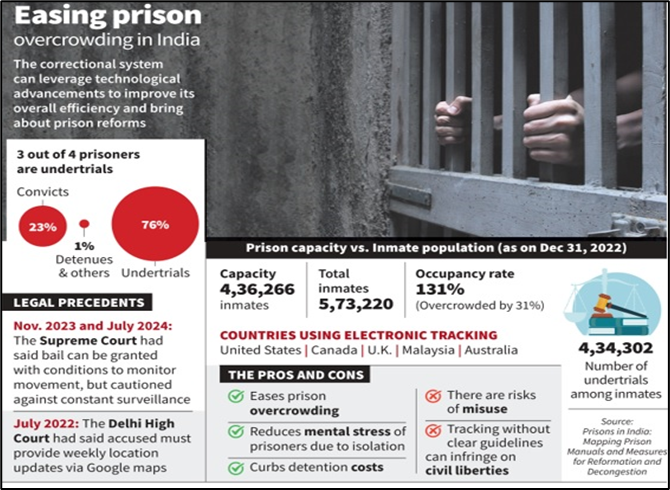Why in News?
India's prison system faces acute challenges, particularly overcrowding, which hinders the efficiency of correctional facilities.
A recent report by the Supreme Court’s Centre for Research and Planning has proposed using electronic tracking devices to address this issue, marking a potential shift in India’s correctional framework.
What’s in Today’s Article?
- Statistics on Overcrowding of Prisons in India
- Key Recommendations in the Report on Prisons in India
- Global Practices and Indian Legal Context on Electronic Monitoring of Prisoners
- Benefits of Electronic Tracking of Prisoners
- Concerns and Safeguards for Electronic Tracking of Prisoners
- Conclusion
Statistics on Overcrowding of Prisons in India:

- As of December 31, 2022, India’s prisons had a 131% occupancy rate with 5,73,220 inmates against a capacity of 4,36,266.
- Undertrial prisoners (UTPs) constitute 75.7% of the total inmate population, amplifying the overcrowding crisis.
Key Recommendations in the Report on Prisons in India:
- The report titled "Prisons in India - Mapping Prison Manuals and Measures for Reformation and Decongestion" was recently released by the President of India.
- It recommends -
- A phased implementation of electronic monitoring for releasing UTPs to ease prison overcrowding.
- The target group in the initial phases will be low and moderate-risk UTPs with good conduct.
- The phased implementation will assess community readiness and the feasibility of electronic tracking for broader use.
Global Practices and Indian Legal Context on Electronic Monitoring of Prisoners:
- International adoption: Countries like the US, UK, Canada, Malaysia, and Australia employ electronic tracking to alleviate prison congestion effectively.
- Indian legislative framework:
- Model Prisons and Correctional Services Act, 2023: Introduced electronic tracking devices as a condition for granting prison leave.
- Law Commission of India’s 2017 Report: Recognised the cost-saving and security benefits of electronic tagging while emphasising caution.
- Judicial developments:
- Courts have imposed location-tracking as bail conditions in select cases.
- The Supreme Court recently disapproved of constant surveillance of bailed individuals, underscoring the need for clear guidelines to balance security and privacy.
Benefits of Electronic Tracking of Prisoners:
- Prison decongestion: Reduces inmate numbers while maintaining oversight.
- Mental health benefits: Improves family contact and reduces stress from isolation.
- Cost-effectiveness: Cuts expenses associated with maintaining high incarceration rates.
- Rehabilitation incentives: Encourages good conduct by linking it with parole or furlough opportunities.
Concerns and Safeguards for Electronic Tracking of Prisoners:
- Risks of misuse:
- Universal application could lead to misuse, infringing on civil liberties.
- Potential operational challenges in ensuring equitable implementation.
- Recommendations for ethical use:
- Clear guidelines for implementation to prevent undue violation of prisoners’ rights.
- Strict safeguards to protect against misuse while achieving the goal of decongestion.
Conclusion:
- Though experts praise tracking devices for easing prison burdens and mitigating mental stress among prisoners, they also warn against universal application, citing risks of misuse and ineffectiveness in some cases.
- The use of electronic tracking devices presents a promising solution to India’s prison overcrowding crisis.
- However, its success hinges on a cautious and well-regulated approach that balances technological benefits with respect for individual rights.









